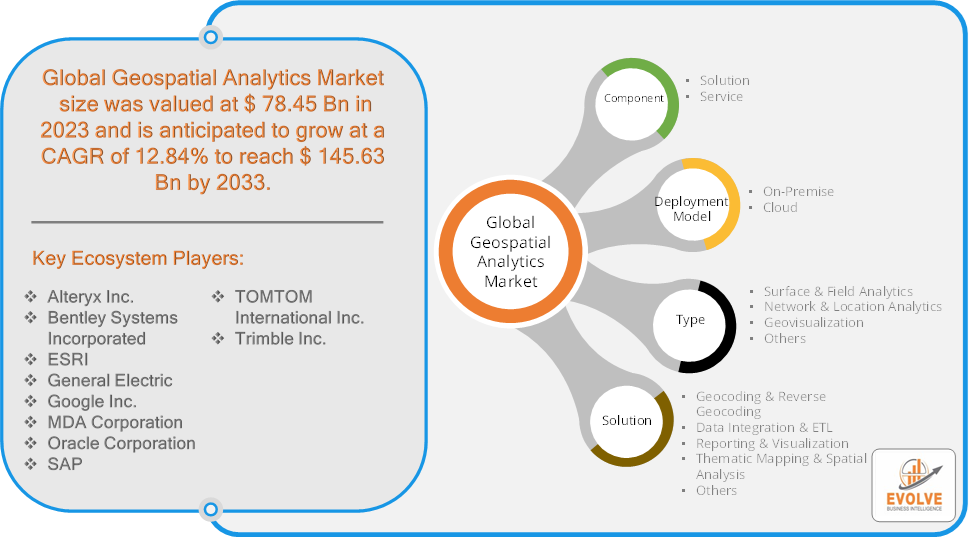Geospatial Analytics Market Soars: 12.84% CAGR

Evolve Business Intelligence has published a research report on the Global Geospatial Analytics Market, 2023–2033. The global Geospatial Analytics Market is projected to exhibit a CAGR of around 12.84% during the forecast period of 2023 to 2033.
Evolve Business Intelligence has recognized the following companies as the key players in the global Geospatial Analytics Market: Alteryx Inc., Bentley Systems Incorporated, ESRI, General Electric, Google Inc., MDA Corporation, Oracle Corporation, SAP, TOMTOM International Inc. and Trimble Inc.
 More Information: https://evolvebi.com/report/geospatial-analytics-market-analysis/
More Information: https://evolvebi.com/report/geospatial-analytics-market-analysis/
Market Highlights
The Global Geospatial Analytics Market is projected to be valued at USD 145.63 Billion by 2033, recording a CAGR of around 12.84% during the forecast period. The Geospatial Analytics Market refers to the industry focused on the collection, analysis, and interpretation of data related to the Earth’s surface. This market involves the use of geospatial data, which includes geographic information such as coordinates, boundaries, and physical features, combined with various technologies to analyze patterns, trends, and relationships in a spatial context. Geospatial analytics is used to provide insights into various applications, including urban planning, agriculture, natural resource management, transportation, defense, and environmental monitoring.
The market is driven by advancements in technology, such as artificial intelligence (AI) and big data analytics, as well as the growing demand for location-based services and the need for effective resource management in various sectors.
The COVID-19 pandemic had a significant impact on the Geospatial Analytics Market. With many industries shifting to remote work, there was an increased reliance on remote sensing technologies and GIS for tasks that traditionally required on-site presence, such as infrastructure monitoring, environmental management, and urban planning. Geospatial analytics played a crucial role in managing healthcare infrastructure by helping to identify areas with higher demand for medical resources, such as hospitals and testing centers. The pandemic accelerated smart city initiatives where geospatial analytics were used to manage public safety, resource allocation, and urban mobility more efficiently, using IoT sensors and data integration platforms. There was an increased focus on using geospatial analytics for public safety applications, such as crowd management, emergency response, and maintaining social order during the pandemic. The pandemic created opportunities for innovation in the geospatial analytics market, particularly in developing new tools and applications for crisis management, predictive modelling, and resource optimization.
Segmental Analysis
The global Geospatial Analytics Market has been segmented based on Component, Deployment Model, Type and Solution.
Based on Component, the Geospatial Analytics Market is segmented into Solution and Service. The Solution segment is anticipated to dominate the market.
Based on Deployment Model, the global Geospatial Analytics Market has been divided into the On-Premise and Cloud. The Cloud segment is anticipated to dominate the market.
Based on Type, the global Geospatial Analytics Market has been divided into the Surface & Field Analytics, Network & Location Analytics, Geovisualization and Others. The Network & Location Analytics segment is anticipated to dominate the market.
Based on Solution, the global Geospatial Analytics Market has been divided into the Geocoding & Reverse Geocoding, Data Integration & ETL, Reporting & Visualization, Thematic Mapping & Spatial Analysis and Others. The Thematic Mapping & Spatial Analysis segment is anticipated to dominate the market.
More Information: https://evolvebi.com/report/geospatial-analytics-market-analysis/
Regional Analysis
The Geospatial Analytics Market is divided into five regions: North America, Europe, Asia-Pacific, South America, and the Middle East, & Africa. North America, particularly the United States, is a leading region in the geospatial analytics market. The region’s dominance is driven by the presence of major technology companies, significant government investments in defense and public safety, and the widespread adoption of advanced technologies like AI and big data. Europe is a significant market for geospatial analytics, with countries like Germany, the United Kingdom, and France leading in technological adoption. The region’s focus on sustainable development, environmental conservation, and smart cities drives demand for geospatial analytics. The Asia-Pacific region is experiencing rapid growth in the geospatial analytics market, driven by economic development, urbanization, and increased government investments in infrastructure and smart city projects. Countries like China, India, Japan, and Australia are key contributors to this growth. Latin America is an emerging market for geospatial analytics, with growing interest in sectors like agriculture, mining, and environmental conservation. Countries such as Brazil, Mexico, and Argentina are key markets in the region. The Middle East and Africa region is increasingly adopting geospatial analytics to support infrastructure development, urbanization, and resource management. The region’s focus on developing smart cities and improving public services drives market growth.


